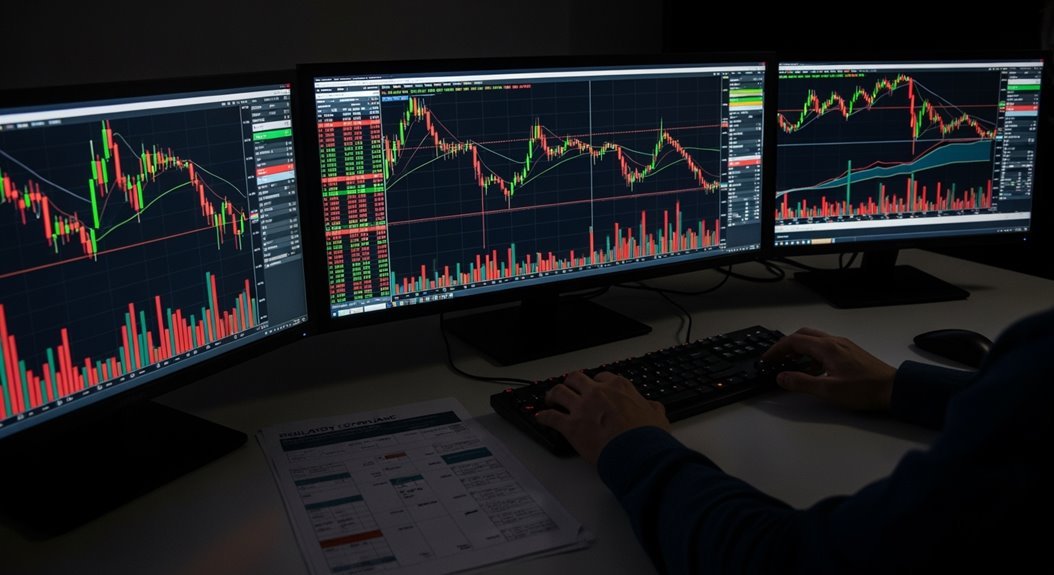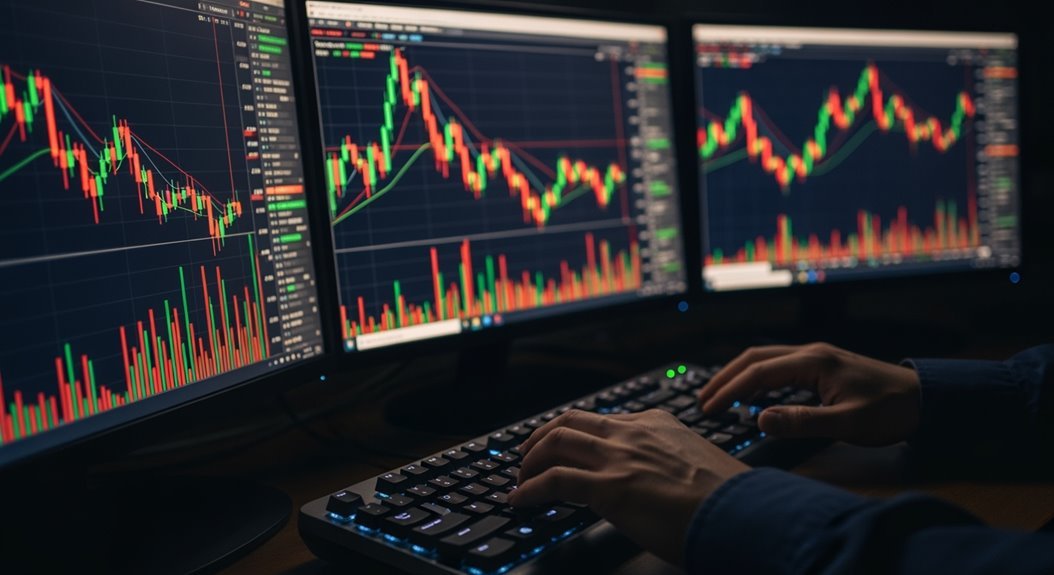Spoofing involves placing large fake orders with intent to cancel them before execution, creating false impressions of market demand or supply. This deceptive practice misleads traders about true market dynamics, distorting natural price discovery. Illegal under Section 4c(a) of the Commodity Exchange Act, spoofing faces enforcement from CFTC, SEC, and DOJ. Violators risk civil penalties, imprisonment, and trading bans. The manipulation increases transaction costs through wider spreads, particularly harming retail traders who lack sophisticated detection tools.
Spoofing Mechanics and Market Impact

Traders manipulate markets through a deceptive practice called spoofing—placing large fake orders they never intend to execute. These massive buy or sell orders sit just outside current market prices. They create false impressions of demand or supply.
The orders vanish quickly. Automated algorithms cancel them once markets react. No actual trades occur on the fake orders.
Spoofers use layering—multiple fake orders at different price levels. This deepens the illusion of market pressure. Quote stuffing floods order books with fleeting orders, confusing competitors and creating timing advantages.
The psychological impact is immediate. Other traders see apparent buying or selling interest. They respond with real trades, amplifying price movements based on phantom signals.
Spoofers then execute genuine trades opposite their fake orders. They profit from artificially induced price swings while others buy high or sell low based on false information. This distorts natural price discovery and undermines market fairness. The resulting wider spreads force all market participants to pay higher transaction costs as liquidity providers adjust their pricing to account for increased risks. These deceptive practices often trigger market maker reactions, as automated systems respond to the artificial signals and adjust their pricing accordingly. Retail traders are particularly vulnerable to these manipulative tactics due to their limited resources and slower execution capabilities.
Legal Framework and Regulatory Enforcement
When lawmakers crafted the Dodd-Frank Act in 2010, they drew a clear line in the sand. Spoofing became explicitly illegal under Section 4c(a) of the Commodity Exchange Act. No more gray areas.
Three agencies now hunt spoofers relentlessly. The CFTC leads enforcement in futures markets. The SEC handles securities violations. The DOJ brings criminal charges that can land traders in prison.
| Agency | Authority | Max Penalties |
|---|---|---|
| CFTC | Civil enforcement, trading bans | $140K or 3x profits per violation |
| SEC | Administrative actions, injunctions | Trading suspensions, disgorgement |
| DOJ | Criminal prosecution | Felony charges, imprisonment |
Courts have consistently upheld spoofing as market manipulation. Even though spoof orders are technically executable, judges recognize the deceptive intent behind them.
Whistleblowers get rewarded handsomely. The SEC and CFTC offer 10-30% of penalties exceeding $1 million. That creates powerful incentives for insiders to report suspicious activity. These reward programs require original evidence to establish eligibility for compensation.
Penalties bite hard. Disgorgement strips away profits. Restitution compensates victims. The CFTC’s interpretation treats spoofing as a per se offense, meaning prosecutors don’t need to prove intent or negligence to establish liability. Trading firms often implement robust security measures to monitor and prevent spoofing activities within their systems.
Common Spoofing Techniques and Detection Methods
Enforcement agencies know what to look for because spoofers leave digital fingerprints everywhere. The most common technique involves placing large buy or sell orders with zero intention to execute. These orders vanish moments before execution.
Layering creates another red flag. Traders stack multiple fake orders at different price levels, painting false pictures of market depth. Then they cancel everything before getting caught.
High-frequency trading makes detection brutal. Algorithms place and cancel orders within milliseconds. The sheer speed overwhelms surveillance systems.
But regulators fight back with sophisticated tools. They monitor order-to-trade ratios, watching for suspicious patterns. Frequent cancellations of large orders trigger alerts. Cross-market surveillance catches spoofers jumping between related markets.
The telltale signs remain consistent: orders with no execution intent, abnormally large sizes, and millisecond lifespans. Spoof orders cluster on one side of the order book, pushing prices artificially. These characteristics help separate manipulation from legitimate trading strategies. Spoofing tactics prove particularly dangerous because they can manipulate derivatives and spot markets simultaneously for the same underlying asset. The practice gained significant attention during the investigation of the 2010 Flash Crash, which erased nearly $1 trillion in market value and led to charges against trader Navinder Singh Sarao. Violations can result in severe financial reparations, including substantial fines and trading bans imposed by regulatory authorities.
Protecting Markets Through Prevention and Compliance

Modern markets demand robust defenses against spoofing manipulation. Regulatory bodies like the SEC and CFTC actively enforce anti-spoofing rules through hefty fines and trading bans. The SEC’s Whistleblower Program has awarded over $1 billion to informants who expose market manipulation.
Technology plays an essential role. Machine learning algorithms analyze massive trading datasets in real-time, flagging suspicious patterns instantly. Advanced surveillance systems enable rapid intervention when spoofing behavior emerges.
Machine learning algorithms and advanced surveillance systems provide real-time detection and rapid intervention against sophisticated spoofing manipulation tactics.
Prevention requires thorough strategies. Organizations must conduct regular risk assessments and develop explicit policies defining suspicious activities. Trading surveillance systems need calibration to specific asset classes to minimize false positives. Firms must submit STORs promptly upon suspicion of market abuse to comply with regulatory requirements.
Employee training proves vital. Staff need education on recognizing spoofing tactics and proper reporting procedures. Regular compliance training reinforces organizational culture against fraud. Traders should focus on placing genuine orders rather than engaging in deceptive practices that create false market impressions.
Documentation matters considerably. Enforcement actions require detailed evidence including communication records and trade data proving intent to defraud. Blockchain technology offers promising solutions for creating tamper-proof trade records. Historical cases demonstrate that market manipulation can escalate into major economic downturns similar to the Great Recession of 2008-2009.
Frequently Asked Questions
How Much Money Do Spoofers Typically Make From Successful Manipulation Schemes?
Spoofers typically earn tens of thousands to millions per manipulation event, depending on market conditions and order size. Navinder Sarao netted millions from his flash crash scheme. JP Morgan’s $920 million fine reflects the massive scale possible. High-frequency spoofers leverage algorithms for rapid profits during volatile periods. Success hinges on liquid markets, tight spreads, and quick execution before detection occurs.
Which Trading Platforms Are Most Vulnerable to Spoofing Attacks?
Major platforms like TD Ameritrade, Charles Schwab, E-Trade, and Fidelity show serious security gaps. Tests reveal 95% failure rates in privacy controls and root detection. Most platforms lack proper encryption and session timeouts. Third-party cloud misconfigurations expose broker data. Password policies remain weak across the industry. Finance platforms face 15.5% of all credential phishing attacks, with spoofed urgent emails targeting users effectively.
Can Retail Investors Accidentally Engage in Spoofing Behavior?
Retail investors can accidentally engage in spoofing behavior through rapid order placement and cancellation patterns. Day traders frequently adjusting positions or testing market sentiment may trigger surveillance systems. Stop-loss modifications in volatile markets can mimic professional spoofing tactics. Most retail traders lack awareness of manipulation rules, increasing violation risks. While enforcement typically targets institutions, repeated suspicious patterns can attract regulatory attention and potential penalties.
What Percentage of Daily Trading Volume Involves Spoofing Activities?
Exact spoofing percentages remain elusive. Academic studies focus on detection rather than volume quantification. Research suggests spoofing represents a small but significant fraction of order placements – typically a subset of total cancellations and modifications. The practice targets thinner order books where impact is greatest. Enforcement agencies have levied $1.26 billion in penalties, indicating substantial activity. However, spoofing’s millisecond nature makes precise daily volume measurement nearly impossible.
How Long Do Spoofing Investigations Usually Take to Complete?
Spoofing investigations typically take one to three years to complete. Simple cases involving individual traders can wrap up within a year. Complex cases with multiple firms or high-frequency trading algorithms stretch much longer. The Navinder Singh Sarao case took years from detection to conviction. CFTC enforcement actions usually resolve within one to two years. Cross-border elements and legal challenges extend timelines considerably.



